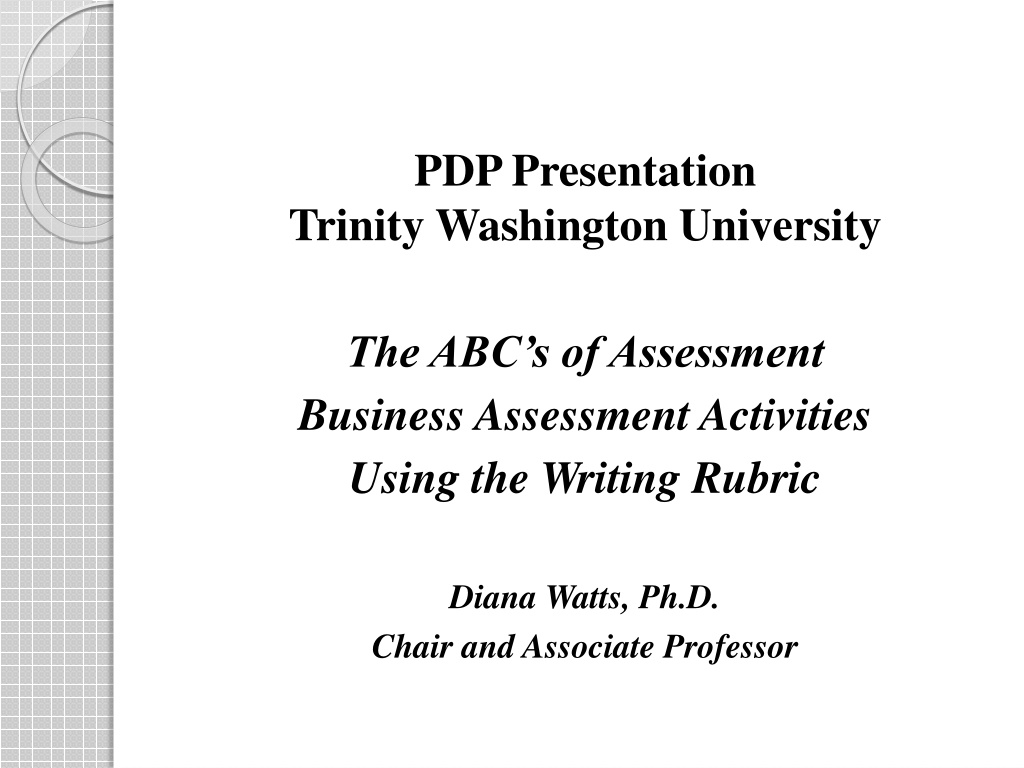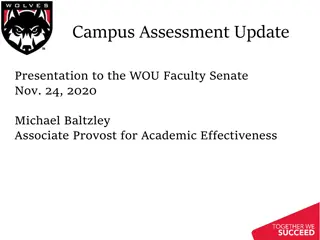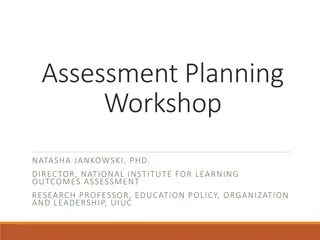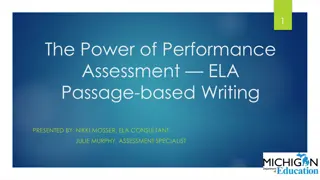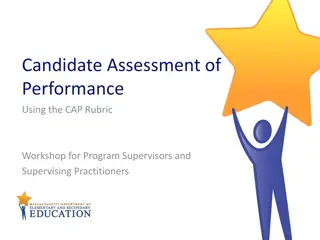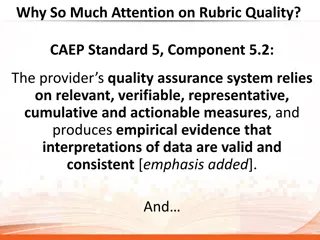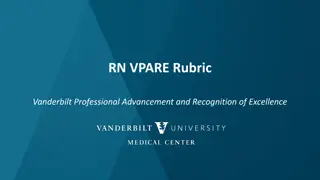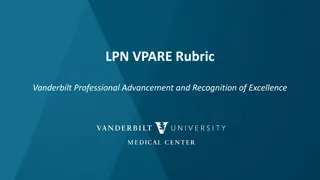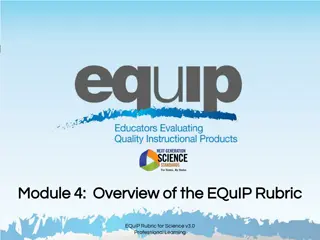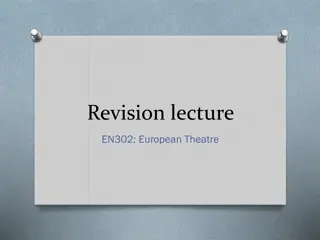Business Assessment Activities Using Writing Rubric
This presentation from Trinity Washington University discusses the ABCs of assessment in business education, focusing on using a writing rubric for evaluating student work. It covers the major requirements, course enrollments, and objectives of the Business Administration (BADM) program. The program's structure, foundational courses, upper-division requirements, and elective options are outlined to provide a comprehensive understanding of the curriculum.
Download Presentation

Please find below an Image/Link to download the presentation.
The content on the website is provided AS IS for your information and personal use only. It may not be sold, licensed, or shared on other websites without obtaining consent from the author.If you encounter any issues during the download, it is possible that the publisher has removed the file from their server.
You are allowed to download the files provided on this website for personal or commercial use, subject to the condition that they are used lawfully. All files are the property of their respective owners.
The content on the website is provided AS IS for your information and personal use only. It may not be sold, licensed, or shared on other websites without obtaining consent from the author.
E N D
Presentation Transcript
PDP Presentation Trinity Washington University The ABC s of Assessment Business Assessment Activities Using the Writing Rubric Diana Watts, Ph.D. Chair and Associate Professor
Teaching Business: BADM Major Requirements Six Foundational Courses BADM 101 Introduction to Business BADM 110 Foundations of Management BADM 226 Organizational Behavior BADM 236 Theories of Leadership ECON 101 & ECON 102: Micro-Macro Sequence Four Upper-Division Required Courses BADM 328 Business/Government/Society PHIL 353 Corporate Social Responsibility & Ethics BADM 426 Strategy & Change BADM 499 Senior Seminar Five Elective Courses (three outside major) Concentration in General or Global Business & Management
Teaching Business: BADM Major Requirements Six Foundational Courses BADM 101 Introduction to Business BADM 110 Foundations of Management BADM 226 Organizational Behavior BADM 236 Theories of Leadership ECON 101 & ECON 102: Micro-Macro Sequence Four Upper-Division Required Courses BADM 328 Business/Government/Society PHIL 353 Corporate Social Responsibility & Ethics BADM 426 Strategy & Change BADM 499 Senior Seminar Five Elective Courses (three outside major) Concentration in General or Global Business & Management
Teaching Business: BADM Course Enrollments COURSE ENROLLMENTS Fall Semester (only) 2009 2010 2011 2012 2013 2014 57 187 203 216 183 218 Students
Teaching Business: BADM Course Enrollments BADM FALL SEMESTER UPPER/ LOWER DIVISION COURSE ENROLLMENTS Fall Semester (only) 2009 2010 2011 2012 2013 2014 141 147 158 125 164 NA Lower Division 101/110/221/226/2 40 46 56 58 58 53 NA Upper Division 328/330/330/426/4 91/498
Teaching Business: Initial Set of Objectives BADM Program Objectives: The program objectives are embedded across the curriculum beginning with six foundational courses to be completed by the end of the sophomore year and four required upper division courses as well as five electives. Three of these electives are to be selected from outside the BADM course offerings, thereby encouraging an interdisciplinary focus. The major is comprised of 45 credit hours and the minor 18 credit hours. At the conclusion of the program students will have mastered the following competencies. - Analyze and communicate understanding of foundational concepts of business, organization and management theories through survey of primary authors. - Develop critical thinking and communication skills (oral/written) to support analysis of complex institutional and behavioral models at both the macro and micro level. - Integrate analytical and empirical skills necessary to represent economic models and financial reasoning. - Develop and apply critical thinking and research methodologies in support of analytic reasoning. - Describe, discuss and analyze the implications of four core thematic issues for business organizations including globalization, whole systems thinking, socially responsible behavior, and diversity. - Identify and discuss the interplay of institutional dynamics (social /political and economic) and their consequences for business organizations (shareholders) and societal outcomes. (stakeholders) -Demonstrate knowledge of multidisciplinary approaches to social inquiry of institutions, organizations and human behavior relevant to business and entrepreneurial activities. - Demonstrate knowledge of multi-cultural contexts and competing ethical frameworks to analyze and evaluate management behavior in the global market place. - Define the role of business organizations and the responsibility/ accountability to support values of social justice. - Describe and discuss historical development of leadership models/ theories. -Enable students to develop self--reflection capabilities to assess their own preparedness for active leadership roles. This range of objectives is to support the development of a multidisciplinary focus that reflects the complexity of modern organizations. This curriculum is based on a strong liberal arts orientation that provides for the development of analytic thinking and presentation of ideas. The focus is intentionally not geared to an operational focus.
Teaching Business: BADM Key Three Objectives Systems as core concept: Identify and analyze the interplay of social /political/economic and environmental institutions and the consequences for business organizations (shareholders) and societal outcomes. (stakeholders) Analysis: Develop and apply analytic reasoning through research, discussion and critical writing. -Values: Demonstrate knowledge of social justice issues as a global citizen, professional and human.
Teaching Business: Developing the Process Define BADM major learning outcomes (2010) Develop curriculum and standard student assessment activities (2010) Develop and apply standard rubric across sections/ years (2012-15) Collect data on student scores Analyze data
Teaching Business: Standard Student Assessments Per semester activities across courses Writing Assignments: 4 Homework: 12-14 (weekly) Quizzes: 4-5 (key term/ short answer) Exams: Midterm/Final
Teaching Business: BADM Standard Rubric Focus on one objective: Analysis: Develop and apply analytic reasoning through research, discussion and critical analysis. Assessment Rubric: standard rubric based on AACU values
Teaching Business in the Broad-Access Classroom Rubric (see handout)
Teaching Business in the Broad-Access Classroom Observations: 1)Iterative versions of similar assignments enabled students to progress with the basic concepts. 2)Working definitions of the concepts to be applied must be developed prior to class through homework assignments. 3)Feedback matters! Directive comments provide basis for student to test ideas and their understanding of concepts and evidence. Multiple homework and quiz structure enabled individualized comments and evaluation. 4)Developmental progression was shown across the semester and within the major with upper-level students in comparison to new students; 5)The ability to challenge concepts attracts students sense of self;
Teaching Business in the Broad-Access Classroom Outcomes To date, learning outcomes are largely anecdotal. -Students self-select for these courses even though it is known that the workload is substantial; -Students begin to recognize common models/ concepts/ empirical questions can be understood and applied across fields/disciplines. -Students appear to become more self-confident in their knowledge-seeking endeavor. (Nakamura, 2005)
Teaching Globalization Studies in the Broad-Access Classroom Next Steps Collect data across courses and across majors with specific questions concerning issue of analysis, complexity and values. Triangulate data with self-report surveys conducted in BADM 110 and BADM 499. Evaluate curriculum and student activities in the context of triggers from the data evaluation.
Teaching Business: BADM Course Enrollments COURSE ENROLLMENTS Fall Semester (only) 2009 2010 2011 2012 2013 2014 57 187 203 216 183 218 Students
Teaching Business: BADM Course Enrollments BADM FALL SEMESTER UPPER/ LOWER DIVISION COURSE ENROLLMENTS Fall Semester (only) 2009 2010 2011 2012 2013 2014 141 147 158 125 164 NA Lower Division 101/110/221/226/2 40 46 56 58 58 53 NA Upper Division 328/330/330/426/4 91/498
Teaching Business: Initial Set of Objectives BADM Program Objectives: The program objectives are embedded across the curriculum beginning with six foundational courses to be completed by the end of the sophomore year and four required upper division courses as well as five electives. Three of these electives are to be selected from outside the BADM course offerings, thereby encouraging an interdisciplinary focus. The major is comprised of 45 credit hours and the minor 18 credit hours. At the conclusion of the program students will have mastered the following competencies. - Analyze and communicate understanding of foundational concepts of business, organization and management theories through survey of primary authors. - Develop critical thinking and communication skills (oral/written) to support analysis of complex institutional and behavioral models at both the macro and micro level. - Integrate analytical and empirical skills necessary to represent economic models and financial reasoning. - Develop and apply critical thinking and research methodologies in support of analytic reasoning. - Describe, discuss and analyze the implications of four core thematic issues for business organizations including globalization, whole systems thinking, socially responsible behavior, and diversity. - Identify and discuss the interplay of institutional dynamics (social /political and economic) and their consequences for business organizations (shareholders) and societal outcomes. (stakeholders) -Demonstrate knowledge of multidisciplinary approaches to social inquiry of institutions, organizations and human behavior relevant to business and entrepreneurial activities. - Demonstrate knowledge of multi-cultural contexts and competing ethical frameworks to analyze and evaluate management behavior in the global market place. - Define the role of business organizations and the responsibility/ accountability to support values of social justice. - Describe and discuss historical development of leadership models/ theories. -Enable students to develop self--reflection capabilities to assess their own preparedness for active leadership roles. This range of objectives is to support the development of a multidisciplinary focus that reflects the complexity of modern organizations. This curriculum is based on a strong liberal arts orientation that provides for the development of analytic thinking and presentation of ideas. The focus is intentionally not geared to an operational focus.
Teaching Business: BADM Key Three Objectives Systems as core concept: Identify and analyze the interplay of social /political/economic and environmental institutions and the consequences for business organizations (shareholders) and societal outcomes. (stakeholders) Analysis: Develop and apply analytic reasoning through research, discussion and critical writing. -Values: Demonstrate knowledge of social justice issues as a global citizen, professional and human.
Teaching Business: Developing the Process Define BADM major learning outcomes (2010) Develop curriculum and standard student assessment activities (2010) Develop and apply standard rubric across sections/ years (2012-15) Collect data on student scores Analyze data
Teaching Business: Standard Student Assessments Per semester activities across courses Writing Assignments: 4 Homework: 12-14 (weekly) Quizzes: 4-5 (key term/ short answer) Exams: Midterm/Final
Teaching Business: BADM Standard Rubric Focus on one objective: Analysis: Develop and apply analytic reasoning through research, discussion and critical analysis. Assessment Rubric: standard rubric based on AACU values
Teaching Business in the Broad-Access Classroom Rubric (see handout)
Teaching Business in the Broad-Access Classroom Observations: 1)Iterative versions of similar assignments enabled students to progress with the basic concepts. 2)Working definitions of the concepts to be applied must be developed prior to class through homework assignments. 3)Feedback matters! Directive comments provide basis for student to test ideas and their understanding of concepts and evidence. Multiple homework and quiz structure enabled individualized comments and evaluation. 4)Developmental progression was shown across the semester and within the major with upper-level students in comparison to new students; 5)The ability to challenge concepts attracts students sense of self;
Teaching Business in the Broad-Access Classroom Outcomes To date, learning outcomes are largely anecdotal. -Students self-select for these courses even though it is known that the workload is substantial; -Students begin to recognize common models/ concepts/ empirical questions can be understood and applied across fields/disciplines. -Students appear to become more self-confident in their knowledge-seeking endeavor. (Nakamura, 2005)
Teaching Globalization Studies in the Broad-Access Classroom Next Steps Collect data across courses and across majors with specific questions concerning issue of analysis, complexity and values. Triangulate data with self-report surveys conducted in BADM 110 and BADM 499. Evaluate curriculum and student activities in the context of triggers from the data evaluation.
